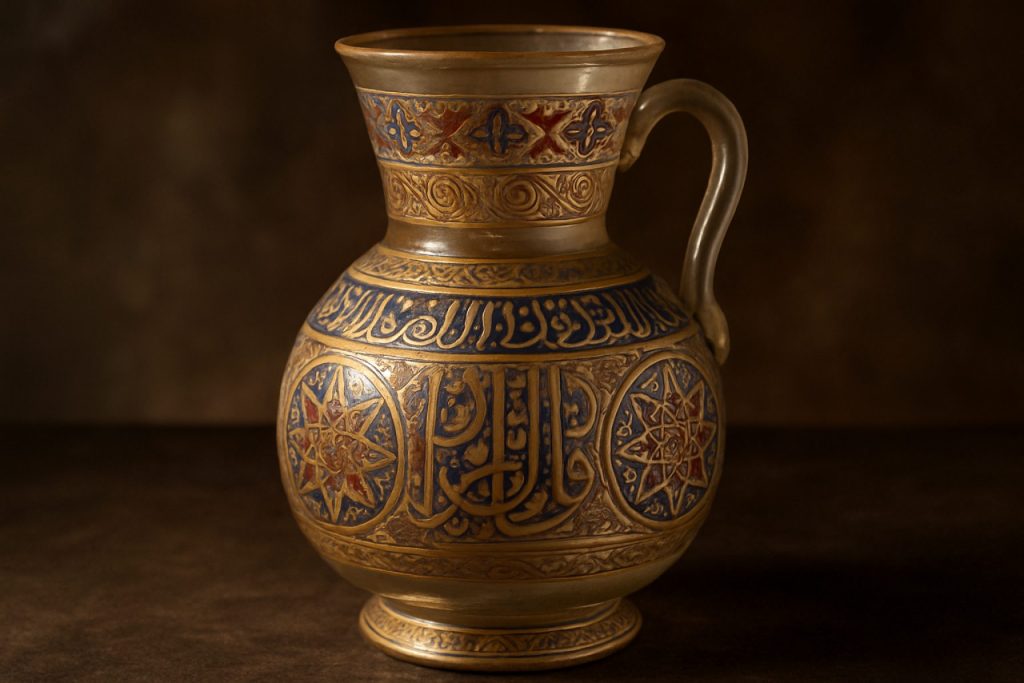
Mamluk Glassware: The Shimmering Masterpieces That Transformed Medieval Decorative Arts. Discover How These Exquisite Creations Continue to Inspire Collectors, Historians, and Designers Worldwide. (2025)
- Origins and Historical Context of Mamluk Glassware
- Signature Techniques: Enameling, Gilding, and Blowing
- Iconography and Symbolism in Mamluk Glass Designs
- Centers of Production: Cairo, Damascus, and Beyond
- Trade, Patronage, and the Spread of Mamluk Glass
- Preservation and Conservation Challenges
- Mamluk Glassware in Modern Museum Collections
- Influence on Contemporary Glass Artists and Designers
- Market Trends and Public Interest: Collecting Mamluk Glassware (Estimated 15% Growth in Public Attention Over the Next Decade)
- Future Outlook: Technological Advances in Analysis and Digital Preservation
- Sources & References
Origins and Historical Context of Mamluk Glassware
Mamluk glassware, renowned for its technical sophistication and artistic brilliance, emerged during the Mamluk Sultanate, which ruled Egypt, Syria, and parts of the Levant from the mid-13th to early 16th centuries. The origins of this glassmaking tradition are deeply rooted in the broader context of Islamic glass production, which itself drew upon earlier innovations from the Roman, Byzantine, and Sasanian empires. The Mamluks inherited and further developed these techniques, establishing their own distinctive style and methods.
The Mamluk period was marked by significant political and economic stability, particularly in Cairo and Damascus, which became major centers of artistic production. The Mamluks, originally slave soldiers who rose to power, were keen patrons of the arts, commissioning mosques, madrasas, and luxury objects, including glassware. Their support fostered a vibrant environment for artisans, who benefited from access to high-quality raw materials and established trade routes that connected the Islamic world with Europe and Asia.
Mamluk glassware is characterized by its use of enamel and gilding, techniques that reached new heights during this era. Artisans produced a wide array of objects, such as mosque lamps, beakers, bottles, and flasks, often decorated with intricate geometric patterns, calligraphy, and heraldic emblems. These motifs not only reflected the aesthetic preferences of the Mamluk elite but also served as symbols of power and piety. The production of mosque lamps, in particular, became emblematic of Mamluk glassmaking, with their elaborate inscriptions and vibrant colors illuminating religious and secular spaces alike.
The historical context of Mamluk glassware is also shaped by the region’s strategic position along major trade routes. Cairo and Damascus were hubs for the exchange of goods, ideas, and technologies, facilitating the diffusion of glassmaking knowledge across the Mediterranean and beyond. This cosmopolitan environment enabled Mamluk artisans to incorporate influences from neighboring cultures while maintaining a distinct identity. The decline of the Mamluk Sultanate in the early 16th century, following the Ottoman conquest, led to a gradual waning of this glassmaking tradition, but its legacy endures in museum collections and ongoing scholarly research.
Today, Mamluk glassware is recognized as a pinnacle of medieval Islamic art, celebrated for its technical innovation and aesthetic refinement. Institutions such as the Metropolitan Museum of Art and the British Museum house significant collections of Mamluk glass, providing valuable resources for the study and appreciation of this remarkable artistic heritage.
Signature Techniques: Enameling, Gilding, and Blowing
Mamluk glassware, produced primarily between the 13th and 15th centuries in Egypt and Syria, is celebrated for its technical sophistication and artistic innovation. Three signature techniques—enameling, gilding, and glassblowing—distinguish Mamluk glass from its contemporaries and have left a lasting legacy in the history of decorative arts.
Enameling was a hallmark of Mamluk glassmaking. This process involved applying colored glass powders, mixed with a binding agent, onto the surface of a glass vessel. The object was then reheated so the enamel fused to the glass, creating vibrant, opaque designs. Mamluk artisans excelled in using enameling to depict intricate geometric patterns, calligraphic inscriptions, and vegetal motifs, often in vivid reds, blues, greens, and whites. The technique allowed for both detailed figuration and bold, abstract decoration, reflecting the broader Islamic aesthetic of the period.
Gilding—the application of gold leaf or gold paint—was frequently combined with enameling to enhance the visual impact of Mamluk glassware. Gold was applied in delicate lines or broad bands, often outlining inscriptions or framing decorative panels. After application, the glass was gently reheated to fix the gold to the surface. The interplay of gold with colored enamels produced a luxurious effect, making these objects highly prized both within the Mamluk Sultanate and in international trade. Gilded glassware was especially prominent in mosque lamps, beakers, and flasks, which were often commissioned by wealthy patrons or rulers.
Glassblowing formed the foundation of Mamluk glass production. Artisans used the free-blowing technique, shaping molten glass by inflating it with a blowpipe and manipulating it with tools. This method allowed for the creation of a wide variety of forms, from slender flasks and goblets to large mosque lamps. The skill of Mamluk glassblowers is evident in the thinness and uniformity of their vessels, as well as in the precision with which they could apply additional elements such as handles, spouts, or decorative trails.
The combination of these techniques resulted in glassware that was both technically advanced and artistically distinctive. Mamluk glass objects were not only utilitarian but also served as symbols of status and piety, often inscribed with dedications or Qur’anic verses. Today, surviving examples are held in major museum collections worldwide, attesting to the enduring significance of Mamluk glassmaking in the broader context of Islamic art and material culture. For further information on the history and techniques of glassmaking, organizations such as the Corning Museum of Glass provide extensive resources and research on the subject.
Iconography and Symbolism in Mamluk Glass Designs
Mamluk glassware, produced primarily between the 13th and 16th centuries in Egypt and Syria, is celebrated for its technical sophistication and rich decorative vocabulary. The iconography and symbolism embedded in Mamluk glass designs reflect the complex social, religious, and political milieu of the Mamluk Sultanate. These vessels, often commissioned for both utilitarian and ceremonial purposes, served as canvases for intricate motifs that communicated status, piety, and allegiance.
A defining feature of Mamluk glass is the use of enamel and gilding to create vibrant, multi-colored surfaces. The iconography on these objects is dominated by a repertoire of geometric patterns, vegetal arabesques, and calligraphic inscriptions. Geometric motifs, such as interlacing stars and polygons, not only demonstrate mathematical prowess but also symbolize the infinite nature of creation, resonating with Islamic philosophical concepts. Vegetal designs, including stylized leaves, vines, and palmettes, evoke the idea of paradise, a recurring theme in Islamic art, and are often arranged in rhythmic, repeating bands that suggest order and harmony.
Calligraphy occupies a central role in Mamluk glassware, with inscriptions typically rendered in elegant thuluth or kufic scripts. These inscriptions frequently include Qur’anic verses, blessings, or the names and titles of patrons, such as sultans, emirs, or high-ranking officials. The presence of a patron’s name not only asserts ownership but also serves as a testament to their piety and generosity. In some cases, the inscriptions invoke divine protection or commemorate significant events, further imbuing the objects with symbolic meaning.
Heraldic emblems, or blazons, are another distinctive element of Mamluk glass iconography. These emblems, often depicting objects like cups, swords, or polo sticks, functioned as personal or familial badges, identifying the patron or owner of the vessel. The use of blazons reflects the hierarchical and militaristic nature of Mamluk society, where visual symbols of rank and allegiance were paramount. Such emblems also facilitated the circulation of glassware as diplomatic gifts, reinforcing political alliances and social bonds.
The synthesis of these motifs on Mamluk glassware illustrates the interplay between artistic innovation and cultural symbolism. The enduring legacy of these designs is evident in their influence on later Islamic and European glassmaking traditions, as recognized by institutions such as the Metropolitan Museum of Art and the British Museum, both of which house significant collections of Mamluk glass. Through their iconography, Mamluk glass objects continue to offer insights into the values, beliefs, and aesthetics of a pivotal era in Islamic history.
Centers of Production: Cairo, Damascus, and Beyond
During the Mamluk period (1250–1517 CE), glassware production reached remarkable heights, with Cairo and Damascus emerging as the principal centers of innovation and craftsmanship. These cities, situated at the crossroads of major trade routes, benefited from access to raw materials, skilled artisans, and vibrant markets, enabling them to become hubs for the manufacture and export of luxury glass objects.
Cairo, the capital of the Mamluk Sultanate, was renowned for its workshops that produced a wide array of glassware, including mosque lamps, beakers, bottles, and inkwells. The city’s artisans were particularly celebrated for their mastery of enamel and gilding techniques, which adorned glass surfaces with intricate calligraphy and geometric motifs. The proximity to the Nile provided both the necessary sand for glassmaking and a means of transporting finished goods throughout the Mediterranean and beyond. Cairo’s glassware was highly prized, often commissioned by religious institutions and wealthy patrons, and frequently bore inscriptions identifying the patron or the workshop.
Damascus, another major center, was equally distinguished for its glass production. The city’s artisans developed distinctive styles, often characterized by bold colors and elaborate decoration. Damascus glassmakers were adept at both free-blown and mold-blown techniques, producing items ranging from utilitarian vessels to ornate mosque lamps. The city’s strategic location facilitated the exchange of artistic ideas and technical knowledge with other regions, further enriching its glassmaking tradition. The products of Damascus workshops were widely traded, reaching as far as Europe and Asia, and were highly sought after for their beauty and craftsmanship.
While Cairo and Damascus were preeminent, other regions under Mamluk control also contributed to the flourishing of glassware. Cities such as Aleppo and Jerusalem hosted smaller but significant workshops, often specializing in particular forms or decorative styles. The widespread distribution of Mamluk glassware is evidenced by archaeological finds across the Mediterranean basin, indicating a robust network of production and trade.
The legacy of Mamluk glassmaking is preserved in museum collections worldwide, where these objects are recognized for their technical sophistication and artistic merit. Institutions such as The Metropolitan Museum of Art and The British Museum house exemplary pieces, underscoring the enduring influence of Cairo, Damascus, and other centers in shaping the history of Islamic glass.
Trade, Patronage, and the Spread of Mamluk Glass
During the Mamluk period (1250–1517 CE), glassware production reached remarkable heights, both artistically and technologically. The Mamluk Sultanate, centered in Egypt and Syria, became a major hub for the manufacture and distribution of luxury glass objects. The flourishing of Mamluk glassware was closely tied to the region’s strategic position along key trade routes, the patronage of the ruling elite, and the dynamic exchange of artistic ideas across the Mediterranean and beyond.
Trade played a pivotal role in the dissemination of Mamluk glass. Cairo, Damascus, and Aleppo were not only centers of production but also vital nodes in international commerce. Mamluk glassware—distinguished by its vibrant enameling, gilding, and intricate forms—was exported widely, reaching markets in Europe, the Islamic world, and even as far as China. Archaeological finds of Mamluk glass in places such as Venice, Cyprus, and the Balkans attest to its far-reaching influence. The movement of these luxury goods was facilitated by the Mamluks’ control over Red Sea and Mediterranean trade, which allowed them to act as intermediaries between East and West. This exchange was not limited to finished products; raw materials and technical knowledge also traveled along these routes, contributing to the evolution of glassmaking techniques in both Islamic and European contexts.
Patronage was another crucial factor in the development of Mamluk glassware. The Mamluk elite—sultans, emirs, and high-ranking officials—commissioned lavish glass objects for religious, ceremonial, and domestic use. Mosque lamps, intricately decorated with Quranic inscriptions and heraldic emblems, are among the most iconic examples. These commissions not only reflected the wealth and piety of their patrons but also served as symbols of political legitimacy and social status. The close relationship between artisans and their patrons fostered innovation and the refinement of decorative techniques, such as enameling and gilding, which became hallmarks of Mamluk glass.
The spread of Mamluk glassware was further enhanced by diplomatic exchanges and gifts. Luxurious glass objects were often presented to foreign rulers and dignitaries, strengthening political alliances and showcasing the sophistication of Mamluk craftsmanship. The influence of Mamluk glass can be seen in the adoption of similar forms and decorative motifs in Venetian and other European glassmaking centers, particularly during the late medieval and early Renaissance periods. Institutions such as The Metropolitan Museum of Art and The British Museum house significant collections of Mamluk glass, underscoring its enduring legacy and widespread appeal.
Preservation and Conservation Challenges
Mamluk glassware, produced between the 13th and 16th centuries in the Eastern Mediterranean, is celebrated for its technical sophistication and artistic beauty. However, the preservation and conservation of these delicate artifacts present significant challenges for museums, collectors, and conservators. The primary issues stem from the inherent fragility of the glass, environmental factors, and the complex history of restoration interventions.
One of the main preservation challenges is the chemical instability of ancient glass. Mamluk glass often contains high levels of alkali, making it susceptible to a process known as “glass disease” or crizzling. This phenomenon occurs when moisture in the air reacts with the glass surface, leading to a network of fine cracks, cloudiness, and eventual flaking. The risk is exacerbated by fluctuating humidity and temperature, which can accelerate deterioration. As a result, institutions such as the British Museum and the Metropolitan Museum of Art maintain strict environmental controls in their display and storage areas to mitigate these effects.
Another significant challenge is the legacy of past restoration efforts. In the 19th and early 20th centuries, restoration materials and techniques were often poorly documented and sometimes damaging. Adhesives and fills used in earlier repairs may discolor, shrink, or chemically interact with the original glass, complicating modern conservation efforts. Today, conservators prioritize reversible and non-invasive methods, guided by research and ethical standards set by organizations such as the International Institute for Conservation of Historic and Artistic Works (IIC).
Handling and display also pose risks. Mamluk glassware is often thin-walled and intricately decorated, making it vulnerable to mechanical damage. Museums employ specialized mounts and supports to minimize stress on the objects, and staff are trained in best practices for handling fragile materials. Additionally, light exposure can fade enamels and gilding, so lighting levels are carefully controlled.
Finally, the documentation and provenance of Mamluk glassware are crucial for both preservation and scholarly research. Accurate records help track the condition of objects over time and inform conservation strategies. Collaborative efforts between museums, research institutions, and international bodies continue to advance the science of glass conservation, ensuring that these remarkable artifacts are preserved for future generations.
Mamluk Glassware in Modern Museum Collections
Mamluk glassware, renowned for its technical sophistication and artistic brilliance, occupies a prominent place in the collections of major museums worldwide. Produced primarily between the 13th and 16th centuries in regions under Mamluk rule—such as Egypt and Syria—these glass objects are celebrated for their intricate enamel decoration, gilding, and innovative forms. Today, Mamluk glassware is not only a testament to the era’s craftsmanship but also a focal point for scholarly research and public exhibition.
Leading institutions such as The Metropolitan Museum of Art and The British Museum house some of the most significant collections of Mamluk glassware. These museums have acquired a variety of objects, including mosque lamps, beakers, bottles, and flasks, many of which are displayed in their Islamic art galleries. The Metropolitan Museum of Art, for example, features several Mamluk mosque lamps, notable for their calligraphic inscriptions and vibrant polychrome enameling, which exemplify the technical and aesthetic achievements of Mamluk artisans.
The British Museum also preserves an extensive array of Mamluk glass, with pieces that illustrate the evolution of glassmaking techniques during the Mamluk period. These include objects with applied trails, gilded motifs, and complex iconography, reflecting both local traditions and cross-cultural influences. The museum’s curatorial efforts have contributed to a deeper understanding of the social, religious, and economic contexts in which these objects were produced and used.
Other prominent institutions, such as the Musée du Louvre and the Victoria and Albert Museum, also maintain important holdings of Mamluk glassware. The Louvre’s Department of Islamic Art, for instance, showcases Mamluk glass in the context of broader Islamic artistic traditions, highlighting the exchange of techniques and motifs across the medieval Mediterranean. The Victoria and Albert Museum in London, with its comprehensive Islamic art collection, provides further opportunities for comparative study and public engagement.
Through ongoing research, conservation, and exhibition, these museums play a crucial role in preserving Mamluk glassware for future generations. Their collections not only safeguard the physical legacy of Mamluk artisans but also foster international scholarship and appreciation for the cultural achievements of the medieval Islamic world.
Influence on Contemporary Glass Artists and Designers
Mamluk glassware, renowned for its intricate enamel decoration and gilding, continues to exert a profound influence on contemporary glass artists and designers in 2025. The Mamluk period (1250–1517 CE), centered in Egypt and Syria, produced glass objects of exceptional technical and artistic sophistication. These historical artifacts, characterized by their vibrant colors, calligraphic inscriptions, and geometric motifs, serve as a wellspring of inspiration for modern practitioners seeking to blend tradition with innovation.
Contemporary glass artists often draw upon the Mamluk aesthetic, reinterpreting its signature features through modern techniques such as lampworking, kiln-forming, and glassblowing. The use of enamel paints and gilded surfaces, hallmarks of Mamluk craftsmanship, has been revived and adapted to suit current artistic sensibilities. For example, artists experiment with layering translucent enamels and metallic leaf to evoke the luminous quality of Mamluk mosque lamps and beakers, while also exploring new forms and scales that reflect contemporary design trends.
Designers in the decorative arts and luxury sectors have also embraced Mamluk motifs, incorporating arabesques, medallions, and calligraphic elements into glassware collections. This cross-cultural dialogue is evident in collaborations between glass studios and museums, where historical Mamluk pieces are studied and reimagined for modern audiences. Such initiatives not only preserve the legacy of Mamluk artisanship but also foster innovation by encouraging artists to experiment with traditional methods and materials.
Institutions such as the The Metropolitan Museum of Art and the Victoria and Albert Museum play a pivotal role in this process by curating extensive collections of Mamluk glass and providing resources for scholarly research and artistic engagement. Their exhibitions and educational programs offer contemporary creators direct access to original Mamluk works, facilitating a deeper understanding of historical techniques and aesthetics. This exposure has led to a resurgence of interest in enamel and gilding processes, as well as a renewed appreciation for the cultural significance of glass in Islamic art.
In summary, the enduring legacy of Mamluk glassware is evident in the work of today’s glass artists and designers, who continue to reinterpret its visual language and technical achievements. By bridging past and present, these practitioners ensure that the spirit of Mamluk innovation remains a vibrant force in the evolution of contemporary glass art.
Market Trends and Public Interest: Collecting Mamluk Glassware (Estimated 15% Growth in Public Attention Over the Next Decade)
Mamluk glassware, renowned for its intricate craftsmanship and historical significance, has witnessed a notable resurgence in public interest and market activity in recent years. This trend is projected to continue, with an estimated 15% growth in public attention over the next decade, driven by a combination of academic research, museum exhibitions, and the expanding global community of collectors. The allure of Mamluk glassware lies in its unique blend of artistic innovation and cultural heritage, originating from the Mamluk Sultanate (1250–1517 CE) in Egypt and Syria, where artisans developed advanced techniques such as gilding, enameling, and mold-blowing.
Major museums and cultural institutions have played a pivotal role in elevating the profile of Mamluk glassware. Institutions such as the The Metropolitan Museum of Art and the The British Museum have curated significant collections and exhibitions, providing both scholarly resources and public access to these artifacts. Their efforts have not only preserved these delicate objects but also fostered a deeper appreciation among the public and academic communities. The increased digitization of collections and virtual exhibitions has further broadened access, allowing enthusiasts and researchers worldwide to engage with Mamluk glassware in unprecedented ways.
The art market has responded to this growing interest, with auction houses and galleries reporting heightened demand for authentic Mamluk glass pieces. Collectors are drawn to the rarity, provenance, and aesthetic qualities of these objects, often viewing them as both cultural treasures and sound investments. The market is also influenced by the broader trend of interest in Islamic art, as evidenced by dedicated departments and sales at leading auction houses. This has led to increased scrutiny regarding authenticity and provenance, with organizations such as the International Council of Museums (ICOM) advocating for ethical collecting practices and the protection of cultural heritage.
Public engagement is further bolstered by educational initiatives and collaborative research projects. Universities and research institutes are increasingly focusing on the technological and historical aspects of Mamluk glass production, often in partnership with museums and conservation bodies. These efforts contribute to a more nuanced understanding of the materials, techniques, and socio-economic contexts that shaped Mamluk glassware, thereby enhancing its appeal to both scholars and the general public.
In summary, the market for Mamluk glassware is poised for sustained growth, underpinned by institutional support, scholarly interest, and a dynamic collector base. As awareness and appreciation continue to rise, Mamluk glassware is likely to remain a focal point in the fields of art history, cultural heritage, and collecting for years to come.
Future Outlook: Technological Advances in Analysis and Digital Preservation
The future of research and preservation of Mamluk glassware is being transformed by rapid technological advances in analytical methods and digital preservation. As of 2025, non-destructive techniques such as portable X-ray fluorescence (pXRF), Raman spectroscopy, and computed tomography (CT) scanning are increasingly employed to analyze the chemical composition, manufacturing techniques, and structural integrity of Mamluk glass artifacts. These methods allow researchers to gain insights into the provenance of raw materials, workshop practices, and trade networks without causing harm to the often fragile objects. Institutions such as The British Museum and The Metropolitan Museum of Art are at the forefront of integrating these technologies into their conservation and research programs, enabling more precise dating and authentication of Mamluk glassware.
Digital preservation is another area experiencing significant growth. High-resolution 3D scanning and photogrammetry are now standard practices for documenting Mamluk glass objects. These digital surrogates serve multiple purposes: they provide a permanent record for future study, facilitate virtual restoration, and allow for broader public access through online collections and virtual exhibitions. The J. Paul Getty Trust and Musée du Louvre are notable for their investment in digital infrastructure, supporting both scholarly research and public engagement with Islamic art collections.
Artificial intelligence (AI) and machine learning are also beginning to play a role in the analysis of Mamluk glassware. Algorithms can assist in pattern recognition, stylistic analysis, and even predictive modeling of object provenance or reconstruction of missing fragments. These tools are expected to become more sophisticated, enabling researchers to process large datasets and identify connections that would be difficult to discern manually.
Looking ahead, international collaboration will be crucial for advancing the study and preservation of Mamluk glassware. Shared digital platforms and open-access databases are being developed to facilitate the exchange of analytical data, images, and research findings among museums, universities, and conservation laboratories worldwide. Organizations such as International Council of Museums (ICOM) are instrumental in setting standards and fostering cooperation in the digital documentation and preservation of cultural heritage.
In summary, the future outlook for Mamluk glassware research is promising, with technological innovation enhancing both the depth of scholarly inquiry and the accessibility of these remarkable artifacts to a global audience.
Sources & References
- Metropolitan Museum of Art
- Metropolitan Museum of Art
- Musée du Louvre
- Victoria and Albert Museum
- International Council of Museums (ICOM)
- J. Paul Getty Trust
- Musée du Louvre
- International Council of Museums (ICOM)



